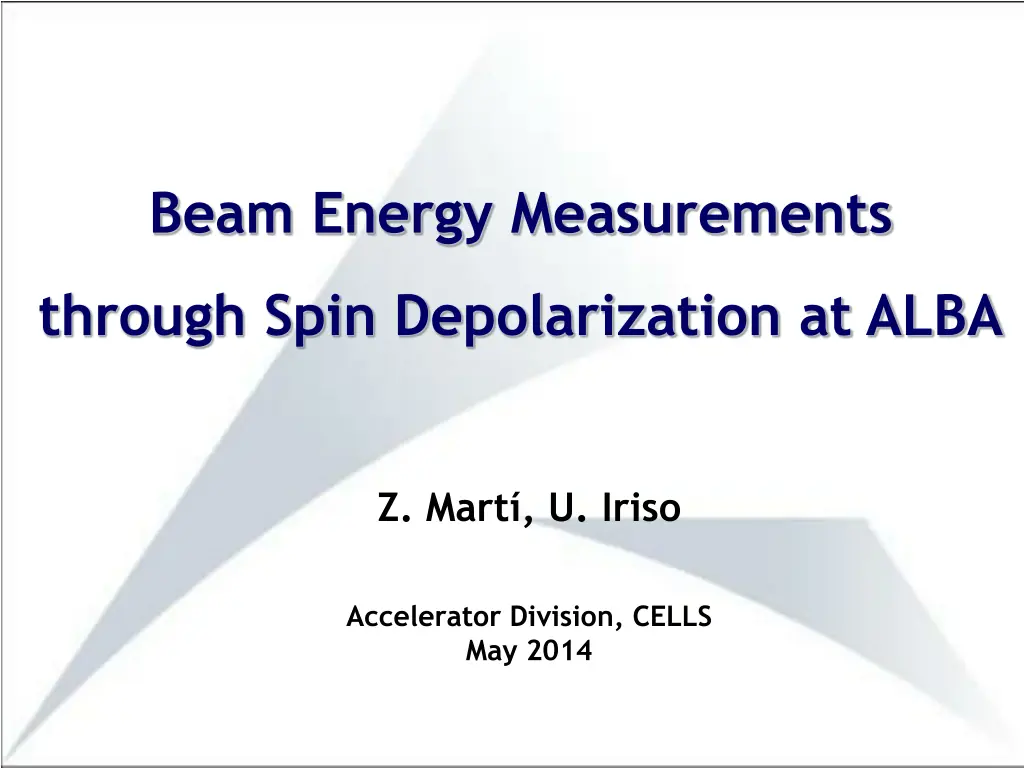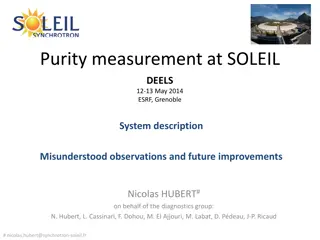
Energy Measurements through Spin Depolarization at ALBAZ.Mart, U. Iriso / Beam Energy Analysis
Explore the process of beam energy measurements via spin depolarization at ALBAZ.Mart, U. Iriso. Learn about the hardware used, measurement techniques, results obtained, and the impact on beam polarization and losses.
Download Presentation

Please find below an Image/Link to download the presentation.
The content on the website is provided AS IS for your information and personal use only. It may not be sold, licensed, or shared on other websites without obtaining consent from the author. If you encounter any issues during the download, it is possible that the publisher has removed the file from their server.
You are allowed to download the files provided on this website for personal or commercial use, subject to the condition that they are used lawfully. All files are the property of their respective owners.
The content on the website is provided AS IS for your information and personal use only. It may not be sold, licensed, or shared on other websites without obtaining consent from the author.
E N D
Presentation Transcript
Beam Energy Measurements through Spin Depolarization at ALBA Z. Mart , U. Iriso Accelerator Division, CELLS May 2014
Introduction: the recipe Inject a fresh beam up to a beam current whose lifetime is limited by Touscheck Wait until beam gets polarized (anti-parallel to the dipole Bfield), noticeable because lifetime increases Scan a vertical excitation at a frequency around expected energy resonant tune. When the vertical excitation is in resonance with the spin tune, and beam gets depolarised When the beam is depolarised, the beam gets a sudden loss, producing: lifetime drops beam losses increase Product (DCCT * lifetime) decays
Excitation Hardware Arbitrary Function Generator - AFG3102 100W Amplifiers Fast Feedback Kickers: Zsh = 45 kOhms Kick: 0.67urad (7 uT m) Kick numbers comparison with other labs (numbers for IPAC references) ALBA Soleil SLS Diamond 7uT m 4.8uT m 3.5uT m 45uT m
Measurement Hardware Lifetime (or product) DCCT Lifetime (or product) using BPMs Sum signal 1 Scintillator based loss monitor (Beam Loss Detector BLD) 120 PinDiodes Bergoz Beam Loss Monitors (BLM) Keees BLD BLD Location in the Ring: Downstream Hor and Ver Scraper Both are slightly closed to increase losses at this location Ubaldo Iriso
Results: Polarization First, build up is confirmed. For this case, BPMs fans and gains shall be fixed. polarization Ubaldo Iriso
First Results: frequency scans Scaning the excitation frequency with steps up to 5Hz/s, no lifetime drop is observed. Instead peaks lifetime. some appear strange in the Suspected moving peaks consistenty. Qy-Qx, the do not but the tunes move Ubaldo Iriso
Peaks study changin WP Qx 0.149 0.156 0.122 Qy 0.355 0.358 0.367 Qy-Qx 0.206 0.202 0.245 Blue Green Red
Full scan: [0 0.5] Ver beam size evolution (blue) during the freq scan The result is that we are full of peaks!! Even if we change the WP, we still get peaks here and there
Zoom on peaks Example: Feb 2014 Qscan=[0.168 0.28] Qspeed: 1.24e-5/sec (rate at which exc. Tune is changed) So, we are a bit lost about the reason for these peaks. Suggestions are welcome WP=(0.1486, 0.3726) ; Qs=0.0056 Nevertheless, let s try to see if we can see some lifetime drop between this forest of peaks 0.2329 0.2103 0.2151 1e-3 2.2e-3 6e-4 Ubaldo Iriso
Two tests at different frf Moving frf by -2kHz ; E=2.994GeV Nominal RF frequency ; E=2.984GeV There seems to be a valley in the lifetime product, which moves consistently with the frf. But it is very difficult to distinguish it among the peaks, where the lifetime increases
Looking at DCCT and BLD BLD counts DCCT Lifetime Rather than a sudden drop, we are looking a slow decay Ubaldo Iriso
Energy Determination Data manipulation based on the beam size evolution Raw Data BLD Evolution removing data when y>1.10* y 0.2352 0.2224 0.2289 According to these peaks in BLD, energy is 2.9837+/-5e4 GeV
Summary and Questions The energy scans at ALBA have been limited by the presence of non understandable resonances These resonances produce vertical beam size increase, which make the lifetime to increase To detect the resonances, best monitor is the beam size To detect losses, best monitor is the scintillator based BLD All in all, the drops in lifetime or sudden increases in BLD seems to indicate a beam energy of 2.984 GeV Precision cannot be fully determined due to the presence of these peaks. Ubaldo Iriso

